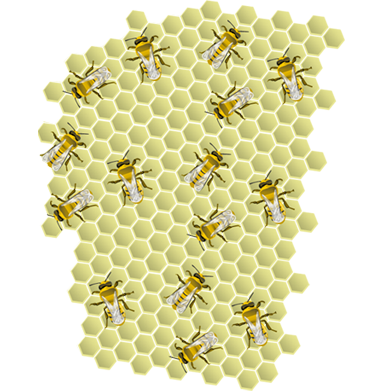
“For the artist, communication with nature remains the most essential condition. The artist is human, himself nature; part of nature within natural space.” Paul Klee
“Nature paints the best part of the picture.” Ralph Waldo Emerson
All living things create patterns. Some patterns we can see and others are invisible to the naked eye. Snowflakes, butterflies, thumbprints, plants and crystals are all secretly structured. Patterns are found in plants and foliage and in animals. Patterns are also constantly being created by simple physical laws. There are patterns in the sand dunes created by blowing winds. There is a pattern in the vortex of a whirlpool and in the formation of an ice crystal. The universe is scaled with patterns, seen and unseen. There is power in pattern. Today scientists, mathematicians, biologists, designers and artists attempt to learn from and imitate nature’s patterns. Unlock the secret connections between the seen and the unseen.
Find the patterns that connect every living thing!
Activity 1 – Pattern Discovery Thumbprint

Starting with your own thumbprint, discover your uniqueness. Take a pad of ink and carefully press your thumb firmly onto the pad. Lift your thumb and press onto a clean sheet of paper. Enlarge your print on a copy machine. Locate the center of the print. Look at the three samples and determine your pattern. Check out family members and friends!
Find you identity pattern!
Activity 2 – Nature Pattern Sleuth

Look around you. What patterns in nature can you find? Take a look around your house, your school, your library, your block, your zoo. In each trip, draw, rub or photograph patterns and label the patterns that you find. Look closely for interesting repetitions of shapes and forms. Nature offers many patterns. Look for bubbles and foams and waves at the water’s edge. Find cracks in the soil. Look for spots and stripes on animals and leaves. Find spirals in vegetables and flowers and animals! Find patterns of symmetry in living things. You may also find interlocking patterns, or tessellations. You may find fractals. Take along your digital camera and sketchbook to record what you discover. Make a pattern grid of your drawn, rubbed and digitally recorded patterns by organizing same size images pasted on a larger poster board. Use your descriptive words to describe the effect of the nature patterns. Where would you use these patterns? On a book cover, a bedspread, wallpaper, carpet, building façade, for a garden plan?
Pattern Power!
Activity 3 – Make A Snowflake

Get some paper and a pair of scissors. Check out the following link and cut away. Fill your windows with lacy snowflakes of every pattern. Want to go digital? Check out SKETCHUP’s video on making amazing snowflakes! Finally, take a look at the beauty of individual patterns at Snowflake Bentley! Click on the snowflakes to see the patterns larger!
Let it snow!
Let it snow!
Let it snow!
Activity 4 – research architects and designers who design with nature patterns

Many artists and architects look to nature to design structure and pattern. The geometry in nature provides many opportunities to initiate a kaleidescope of shapes. Look at a few of these nature investigators. See what they see in nature’s beauty. What pattern would you like to follow? Choose one and create a composition.What geometry will you use to organize it?
Le Corbusier
Louis Sullivan
Andy Goldsworthy
Frank Lloyd Wright
Erwin Hauer
Activity 5 – make a nature pattern

Look around at what nature delivers. Large and small, visible and invisible. If possible, walk outside and record patterns that you find. They may be regular or irregular. They may be geometric or organic. They may repeat or interpolate. Nature patterns are beautiful when looked at closely. They are beautiful at a large scale. Take a look at images of the earth from above on Google Images. If you cannot go outside and observe nature first hand, Google nature patterns. Nature patterns are beautiful at a human scale and at a nano scale. Select some from the scale that interests you and create your own compositional collage using nature’s ways.
Activity 6 – Draw along Nature Patterns
Review

- Nature is full of patterns at all different scales.
- Snowflakes are repetitive forms.
- List three patterns that you see beside your computer. Then list six patterns you can study looking outside of a window.
- How do artists and designers use pattern?
- Pattern cannot be used to enrich the visual experience of an object or environment.
Explore
- Anatomy of a BEE hive!
- Aptum Architecture
- BioDesign Challenge
- Calatrava's UAE Pavilion Photographed by S. Aboudaram
- Five Snowflake Patterns
- Fractal Patterns in Nature
- Fresh Water Snails
- Grand Canyon National Geographic Flyover
- Guide to Snowcrystal Shapes and Patterns
- Howard Stein: Patterns
- Jennifer Angus Insect Patterns and More!
- Kerry Joyce Textiles
- Live Wind Map
- Murmurations (flocks of starlings)
- Nano Animation
- Nature Patterns Theme Park
- Nature Patterns Wikipedia
- Nautilus Shells
- Ned Kahn: Fog/Water/Fire/Light/Wind/Sand
- NOAA SciJinks Snowflakes
- Patterns in Nature You Tube by Amy Klamb
- Patterns Natural & Manmade
- Prairie Lines Photographs by William Harper
- Printing From Nature
- SAVE NATURE
- Sea Things By Rae Eames
- Secret Worlds: The Universe Within
- Smith / Gill Architects
- Snowflakes by Snowflake Bentley
- Snowflakes online!
- Spiderwebs
- Spirals In Nature and Art, 1903 Geoffrey Cook from Leonard Da Vinci
- Terrapin 14 Patterns of Biophilic Design
- Video Creating the Never-Ending Bloom
- Video Decoding Nature Patterns
- Videos Finding Patterns in Nature
- Video Snowflake Bentley
- Video Snowflakes w/ SketchUP
- Wolfgang Buttress The Hive
- Write Your Name With Butterfly Patterns













































